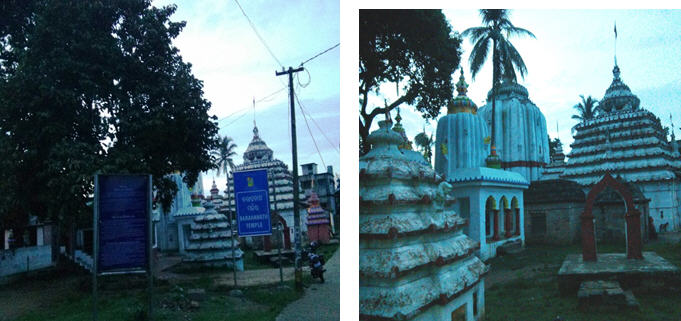
The *Varahanatha Temple*, also known as *Yajna Varaha Temple*, is a beautiful temple located on the left bank of the Vaitarani River on an island formed by the division of river. The main shrine is dedicated to Varaha , the boar avatar of the Lord Vishnu. Built in 15-16th century, the temple is constructed in Kalinga architectural style. This Ancient Varaha temple once had 4 deities – while 3 deities of Varaha are still here (Yajna varaha, Vishanu varaha and adi varaha). 4th deity named as Laxmi varaha was taken by king Ali across viraja to Kendrapara. Also on the altar is deity of Lord Jagannatha. This temple is said to have build by King Prataprudra under direction of Kashi misra.
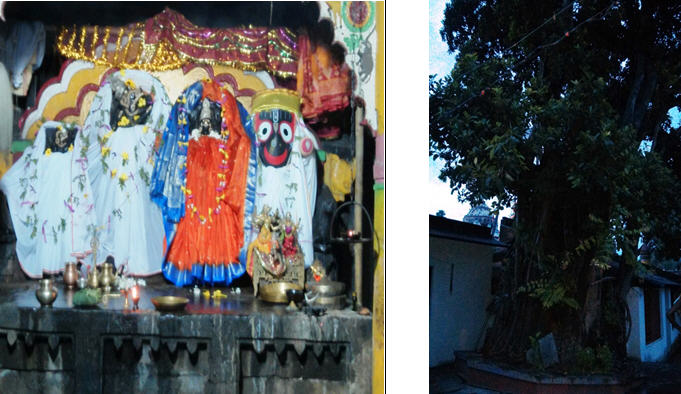
In Varaha temple is also Samadhi of a bird- A small bird landed on lap of Lord chaitanya when he came here. Lord was sitting under a Banyan tree. The bird sat on lap and sang some songs and in front of everyone left her body and went directly to the spiritual world. The Banyan tree is still here and in the base of the tree is the Samadhi of the bird.
At Varaha temple is also temple of Lord Jagannath , Bimala devi, Surya narayan and 9 devis.
The temple complex is located at an elevation of 15 feet (4.6 m), on an island created by two branches of the Vaitarani River, about 1 kilometre (0.62 mi) from Jajpur bus station. The island is opposite to the Dasaswamedha ghat which is also a famous pilgrimage centre.
Lord Chaitanya grand father Upendra Mishra was from aJajpur. Then he shifted to Srihatta in Bangladesh and later the son Jagannath Mishra settled in Navadvip. ————-
Lord Chaitanya’s first visit to Jajapur on his way to puri
Srila Bhaktisiddhanta Sarasvati Thakura in his commentary to Chaitanya bhagavat states that while Sri Caitanya Mahaprabhu passed through Bengal, He passed through Atisara-grama, Varaha-grama and Chatrabhoga. He then reached the Orissa province, where He passed through Prayaga-ghata; the Suvarnarekha River; Remuna; Yajapura, where He bathed at the Dasasvamedha-ghata, on the Vaitarani River; Kataka (Cuttak), where the Mahanadi River flows; Bhuvanesvara, where there is a big lake known as Bindu-sarovara; Kamalapura; and Atharanala. In this way, passing through all these and other places, He reached Jagannatha Puri.
Chaitanya bhagavat antya 2.280 Chapter Two: Description of the Lord's Travel Through Bhuvanesvara and Other Placesto Jagannatha Puri
TEXT 280
kata-dine mahaprabhu sri-gaurasundara
ailena yajapure—brahmana-nagara
Within a few days Sri Gaurasundara Mahaprabhu arrived at the Brahmana-nagara locality of Yajapura. The footprints of Sri Gaurasundara have been established in the Adi-Varaha temple, which is situated in the Brahmana-nagara neighborhood of Yajapura. These footprints were established in memory of the mother of Sriyukta Mohini Mohana Raya Chaudhuri Mahasaya, the landlord of Baliyati village.
TEXT 281 yanhi adi-varahera adbhuta prakasa
yanra darasane haya sarva-bandha-nasa
At that place there is a wonderful Deity of Adi-Varaha. By taking darsana of this Deity, all one's material bondage is destroyed.
TEXT 282
mahatirtha-vahe yatha nadi vaitarani
yanra darasane papa palaya apani
The most sacred Vaitarani River flows past this place. One's sinful reactions flee away upon seeing this river.
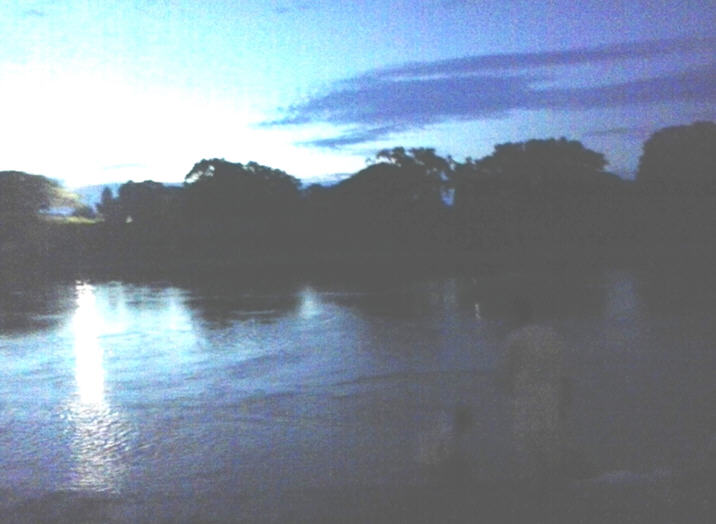
Purport – The word vaitaraniin this verse refers to the Vaitarani River. Yajapura, also known as Nabhi-gaya, is situated in the place known as Viraja-ksetra on the bank of this river.
TEXT 283
jantu-matra ye nadira hailei para
deva-gane dekhe catur-bhujera akara
If even an animal crosses that river the demigods see it as having a four-armed form.
TEXT 284
nabhi-gayaviraja-devira yatha sthana
yatha haite ksetra—dasa-yojana-pramana
The deity of Viraja-devi is situated in Nabhi-gaya, which is eighty miles from Jagannatha Puri.
TEXT 285
yajapure yateka achaye deva-sthana
laksa vatsare o nari laite saba nama
I am unable to name the numerous temples in Yajapura even in a hundred thousand years. Purport -Another name of Nabhi-gaya is Viraja-ksetra. This place is situated within Yajapura. This place is situated eighty miles from Nilacala.
TEXT 286
devalaya nahi hena nahi tathi sthana
kevala devera vasa—yajapura grama
The village of Yajapura consists of all varieties of temples with all varieties of deities.
TEXT 287
prathame dasasvamedha ghate nyasi-mani
snana karilena bhakta-samhati apani
The crest jewel of the sannyasis first took bath with the devotees at Dasasvamedha-ghata.
TEXT 288
tabe prabhu gela adi-varaha sambhase
vistara karila nrtya-gita prema-rase
Thereafter the Lord joyfully visited the Adi-Varaha temple, where He relished ecstatic love while dancing and chanting.
TEXT 289
bada sukhi haila prabhu dekhi' yajapura
punah punah bade anandavesa pracura
The Lord was greatly pleased to see Yajapura. His ecstasy repeatedly increased there.
Purport -It is said that Yajapura is a corrupted form of Yayatipura, which is derived from the name Yayati Kesari, a Saivite king of Orissa. In other's opinion the name Yajapura is derived from the word yajnanusthana (“a place of sacrifice”) or yajana (“worship”). Sriman Mahaprabhu made His auspicious arrival in Yajapura in A.D. 1511. The temple of Sri Varahadeva is situated in Yajapura. Sriman Mahaprabhu displayed the pastime of offering obeisances, chanting, and dancing before Sri Varahadeva. It is described in Sri Caitanya-caritamrta (Madhya 5.3-4):
calite calite aila yajapura-grama
varaha-thakura dekhi' karila pranama
nrtya-gita kaila preme bahuta stavana
yajapure se ratri karila yapana
“Walking and walking, Sri Caitanya Mahaprabhu and His party finally arrived at Yajapura, on the river Vaitarani. There He saw the temple of Varahadeva and offered His obeisances unto Him. In the temple of Varahadeva, Sri Caitanya Mahaprabhu engaged in chanting and dancing and offered prayers. He passed that night in the temple.”
Madhya 5.6 In Sri Caitanya-caritamrta there is an indication that Mahaprabhu came to Yajapura another time. In the year when Sriman Mahaprabhu had a disagreement with Srila Gadadhara Pandita Gosvami Prabhu regarding his residing in Nilacala as a resident sannyasi, Sri Gaurasundara came to Yajapura with Sri Raya Ramananda and the two Mahapatras, Mangaraja and Haricandana. Mahaprabhu then bid farewell to the two Mahapatras at Yajapura. (See Sri Caitanya-caritamrta, Madhya-lila, Chapter Sixteen, verse 150.)
The two stone Deities of Sri Varahadeva are attached to each other. On the left of the Deities there is a stone deity of Sri Laksmi, and on her left there is a Deity of Sri Jagannathadeva. In front of them there is a smaller set of Laksmi-Varaha deities made of metal. From the Yajapura Road railway station one must take three buses and cross two rivers to travel the seventeen miles to the temple of Varahadeva. On both banks of both rivers there are connecting buses waiting to transport passengers. After traveling nine miles in one bus, one crosses the first river called Yamuna Khai. Then one has to walk six miles to the next river called Buda. After crossing this river, one catches a connecting bus. There is a dharmasala in Yajapura known as Radhabai Dharmasala or Jagannatha Dharmasala. It is situated near the ancient temple of Jagannatha. The footprints of Sri Caitanya were established in Yajapura on December 25, 1930. For an elaborate description of this one should see Gaudiya, Volume 10, Part 2.
TEXT 290
ke jane ki iccha tana dharileka mane
saba' chadi' eka palailena apane
Who knows what was His desire? Suddenly He left everyone behind and went away.
TEXT 291
prabhu na dekhiya sabe haila vikala
devalaya cahi' cahi' bulena sakala
When the devotees saw the Lord was not there, they became confused. They began to search for the Lord in the various temples.
TEXT 292
na paiya kothao prabhura anvesana
parama cintita hailena bhakta-gana
When they could not find the Lord anywhere, they became filled with anxiety.
TEXT 293
nityananda bale,—“sabe sthira kara citta
janilana prabhu giyachena ye nimitta
Nityananda said, “Everyone calm down. I know why the Lord has left.
TEXT 294
nibhrte thakura saba yajapura-grama dekhibena devalaya yata punya-sthana “The Lord wants to visit all the holy places and temples of Yajapura alone.
TEXT 295
amara o sabe bhiksa kari' ei thani aji thaki, kali prabhu paiba ethai” “We should all beg alms and stay here today. We will meet the Lord here tomorrow.”
TEXT 296
sei mata karilena sarva bhakta-gana bhiksa kari' ani' sabe karila bhojana In this way all the devotees went out to beg alms, and then they ate together. TEXT 297 prabhu o buliya saba yajapura-grama dekhiya yateka yajapura-punya-sthana And the Lord wandered around Yajapura visiting all the holy places there.
TEXT 298
sarva bhakta-gana yatha achena vasiya ara dine sei sthane milila asiya The next day the Lord returned to where the devotees were waiting.
TEXT 299
athe-vyathe bhakta-gana `hari hari' bali' uthilena sabei haiya kutuhali Immediately the devotees enthusiastically jumped up and chanted, “Hari! Hari!”
TEXT 300
saba'-saha prabhu yajapura dhanya kari' calilena `hari' bali' gauranga sri-hari After making Yajapura glorious, Lord Gauranga chanted the name of Hari while departing with His associates.- Lord Chaitanya’s second visit to Jajpur on his attempt to go to Vrindavan – Chaitanya charitamrita Madhya 16.153
TEXT 150
dui raja-patra yei prabhu-sange yaya ‘yajapura’ asi’ prabhu tare dilena vidaya
TRANSLATION When Sri Caitanya Mahaprabhu and His party arrived at Yajapura, the Lord asked the two government officers who had come with Him to return.
PURPORT The place called Yajapura is very well known in Orissa. It is a subdivision of the Kataka district and is situated on the southern side of the Vaitarani River. Formerly great sages performed sacrifices on the northern bank of the Vaitarani River; consequently the place is known as Yajapura, “the place where sacrifices are performed.” Some people say that this was one of the capital cities of King Yayati and that from the name Yayati-nagara the name Yajapura has come. As stated in the Mahabharata (Vana-parva, Chapter 114): ete kalingah kaunteya yatra vaitarani nadi yatrayajata dharmo ’pi devan saranam etya vai atra vai rsayo ’nye ca pura kratubhir ijire According to the Mahabharata, great sages formerly performed sacrifices in this place. There are still many temples of demigods and incarnations there, and there is also a Deity of Sri Varahadeva. This Deity is especially important and is visited by many pilgrims. Those who worship the Supreme Lord’s energy worship Varahi, Vaisnavi and Indrani, as well as many similar forms of Devi, the internal energy. There are many deities of Lord Siva, and there are many places along the river known as Dasasvamedha-ghata. Sometimes Yajapura is also called Nabhi-gaya or Viraja-ksetra.
TEXT 151 prabhu vidaya dila, raya yaya tanra sane krsna-katha ramananda-sane ratri-dine
TRANSLATION Sri Caitanya Mahaprabhu bade farewell to the officers, and Raya Ramananda continued on with the Lord. The Lord talked to Ramananda Raya about Sri Krsna day and night.
TEXT 152 prati-grame raja-ajnaya raja-bhrtya-gana navya grhe nana-dravye karaye sevana
TRANSLATION In each and every village, in compliance with the King’s order, government officers constructed new houses and filled each of them with stocks of grain. Thus they served the Lord.
TEXT 153 ei-mata cali’ prabhu ‘remuna’ aila tatha haite ramananda-raye vidaya dila
TRANSLATION Sri Caitanya Mahaprabhu finally arrived at Remuna, where He bade farewell to Sri Ramananda Raya. Srila Bhaktisidhanta saraswati Thakur visits at Jajpur – To commomerate Lord Chaitanya visit to Jajpur, Srila Sarasvati Thakur installed foot prints of Lord Chaitanya on 25th December 1930.
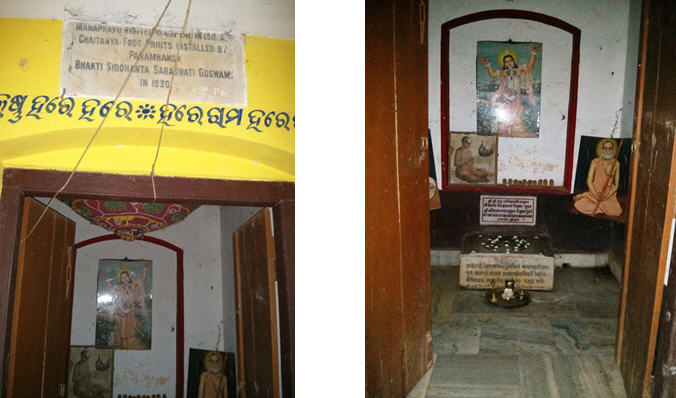
Later in 1932, Sarasvati Thakura came to Jajpur in Orissa, where he visited the Varahadeva Deity and the descendents of Mahaprabhu. Sarasvati Thakura stayed in the Jagannatha dharmashala. There, on the other side of the Vaitarani river, which is closeby , there is also the Viraja temple.
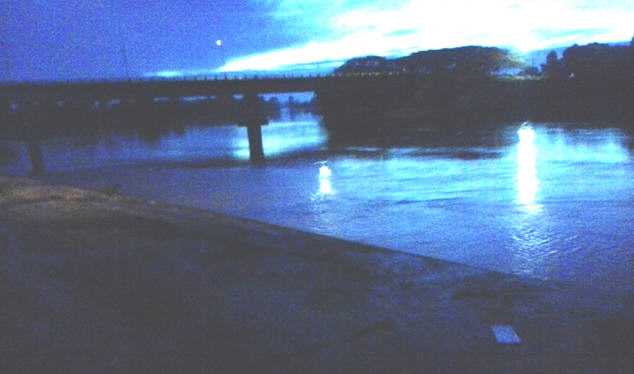
One has to cross the Gauranga palli (palli means "bridge") to get to viraja temple. While crossing the Vaitarani ,Sarasvati Thakura said "If you cross the Vaitarani you will cross the Viraja (spiritual world)." Or in other words, you will reach the spiritual world. This is, of course, in reference to the Vaitarani of Viraja river, which is at the border of the material world. One side is the material world and the other side is the spiritual world. One has to cross over the Viraja river to come out of the material; world to the spiritual world. Viraja means Vigata Raja, or without tama and raja, without the modes of ignorance and passion. They came at night to Jajpur station which was in the middle of the jungle at that time, infested with tigers.Tigers were roaring, and Sarasvati Thakura asked, "Oh, are they tigers roaring?" "Yes," came the reply. From Jajpur Sarasvati Thakura went to Kurmaksetra, Mangalagiri, Singhachalam; all these places for establishing the footprints of Lord Caitanya.
Another time in earier years, Sarasvati Thakura came here. While delivering his class he spoke in a public meeting about the "dasa-vidha nama aparadha". The king postulated to Sarasvati Thakura that when chanting the names why worry about offenses, as the name can be chanted in any manner? Sarasvati Thakura quoted the ten offenses from the Padma Purana. The sadhus who were present there were propagating chanting without bothering about offenses and they didn't believe Sarasvati Thakura's quote from the Padma Purana, so he said to the doubtful king, "I'll show you how this is true." The meeting was organized from 4.00pm to 9.00pm, but Sarasvati Thakura said the sadhus should stay from 5.00pm to 7.00pm (the evening sandhya, time for taking ganja, opium). Sarasvati Thakura said that all the sadhus should stay. We'll be having sankirtana and hari-katha, they should not go outside. Thousands of sadhus gathered for the meeting, but the meeting was from 5.00pm to 7.00pm, so by 6.00pm, many of the sadhus had left the meeting, because they had the habit to smoke ganja or tobacco, or take tea. They could not stay seated for the full two hours for Hari katha. Sarasvati Thakura showed the king, saying, "Just see what is the situation. Because they are addicted to opium, ganja, tea, cigarettes, etc., they cannot stay for the recitation of the holy name. Is this not due to their offenses?" The king then understood. Sarasvati Thakura finally instructed that these five things should be given up by serious reciters of the holy name: Meat eating, gambling, illicit sex, intoxication, and the search for money, because these are the five places where Kali resides. The king accepted this and became his disciple, taking Harinama initiation.